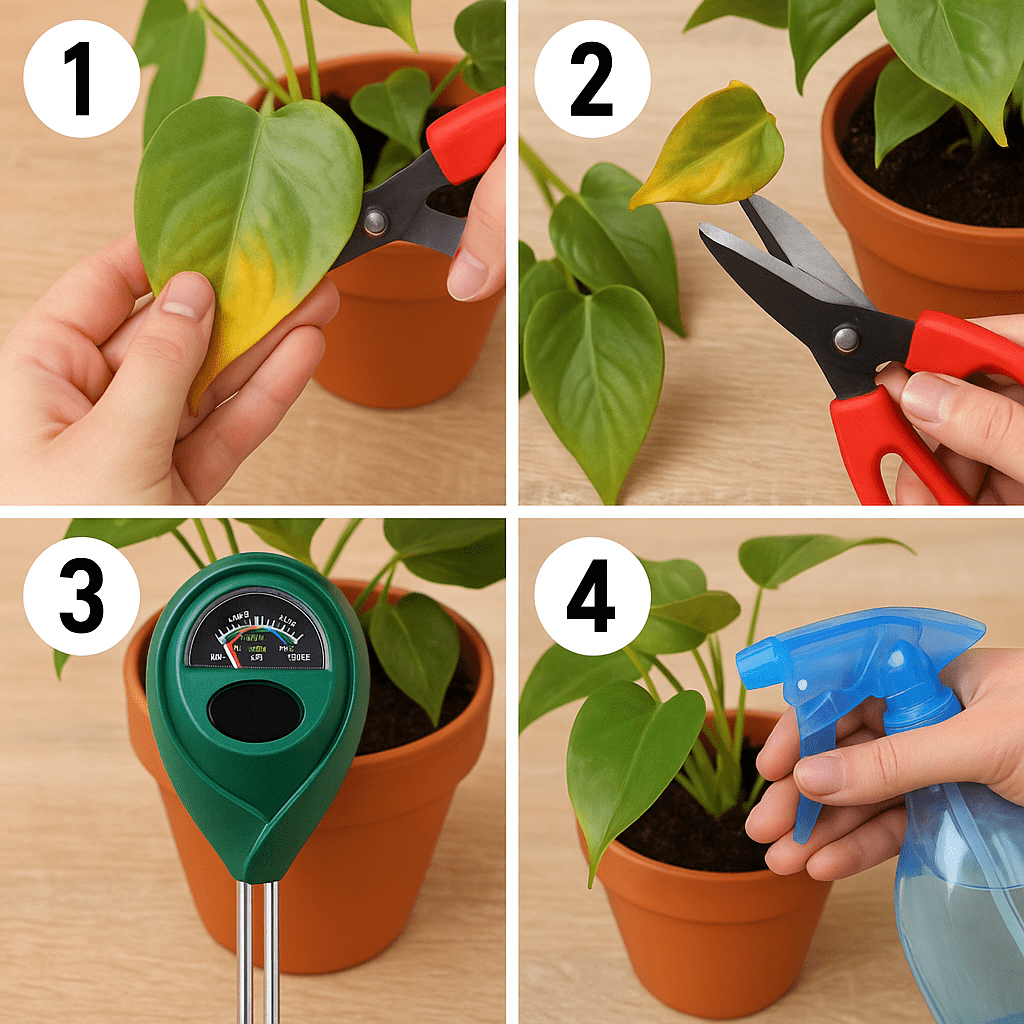If you’ve noticed that the leaves of your beloved houseplants are turning yellow, you’re not alone. Leaf yellowing, or chlorosis, is one of the most common problems faced by plant owners—especially beginners. The good news? Most causes of yellowing leaves are completely fixable once you understand what’s going on.
In this guide, we’ll explore why your leaves are turning yellow and provide practical, step-by-step solutions to revive your plant’s health.
Common Causes of Yellowing Leaves
1. Overwatering
Overwatering is the #1 reason leaves turn yellow. When roots sit in soggy soil for too long, they can’t breathe and start to rot.
Signs:
- Mushy or black roots
- Soil stays wet for several days
- Leaves are soft and yellow
Solution:
- Allow soil to dry between waterings
- Use pots with drainage holes
- Consider a well-draining soil mix
2. Underwatering
Just as too much water is harmful, too little can also lead to yellowing, especially for plants that need consistent moisture.
Signs:
- Dry, brittle soil
- Leaves feel crispy and wilted
- Curling or drooping foliage
Solution:
- Check moisture levels regularly
- Water thoroughly when top inch of soil is dry
- Avoid letting soil become bone-dry
3. Lack of Nutrients
Plants require a range of nutrients, and a deficiency in nitrogen, iron, or magnesium can cause yellowing.
Signs:
- Uniform yellowing (nitrogen)
- Yellow between leaf veins (iron or magnesium)
- Slow growth
Solution:
- Use a balanced, water-soluble fertilizer
- Repot using fresh, nutrient-rich potting mix
- Avoid over-fertilizing, which can burn roots
4. Poor Drainage or Compacted Soil
If your potting mix is old or too dense, it can retain water or restrict airflow to the roots.
Solution:
- Use lightweight, well-aerated potting soil
- Add perlite or sand to improve drainage
- Repot if soil is compacted or smells musty
5. Incorrect Light Levels
Too much or too little light stresses the plant and causes leaf discoloration.
Signs:
- Yellowing and scorched spots (too much sun)
- Pale or drooping leaves (too little light)
Solution:
- Research your plant’s specific light needs
- Move to a brighter or shadier location accordingly
- Rotate plant weekly for even light exposure
Step-by-Step: How to Fix Yellow Leaves
Step 1: Diagnose the Problem
Check the soil, light, and roots. Look for overwatering, dryness, pests, or signs of nutrient deficiency.
Step 2: Adjust Watering Routine
Use the finger test: stick your finger one inch into the soil. If it’s dry, water. If it’s moist, wait a few more days.
Step 3: Repot If Necessary
If the soil is compacted, moldy, or smells foul, repot the plant with fresh soil and trim any rotted roots.
Step 4: Feed Your Plant
Apply an appropriate fertilizer based on the plant species. Follow instructions carefully to avoid fertilizer burn.
Step 5: Prune Yellow Leaves
Keep an eye on your plant for the next few weeks. Healthy new growth is a good sign you’re on the right track.
Step 6: Monitor and Adjust
Keep an eye on your plant for the next few weeks. Healthy new growth is a good sign you’re on the right track.

Prevention Tips
- Stick to a regular watering schedule
- Avoid placing plants near heating/cooling vents
- Use filtered or dechlorinated water for sensitive plants
- Clean leaves occasionally to prevent dust buildup
- Keep a care journal to track issues and progress
For more tips on how to avoid watering mistakes, check out our complete guide on watering plants correctly.
Conclusion
Yellowing leaves may look alarming, but they’re often a sign that your plant is simply asking for help. With the right diagnosis and care adjustments, your plant can bounce back quickly.
Save this guide for the next time your plant starts to look a little pale — or share it with a friend who just bought their first houseplant!
FAQ
Q: Should I cut off yellow leaves?
A: Yes, if the entire leaf has turned yellow. Removing them helps the plant conserve energy and focus on new growth.
Q: Can yellow leaves turn green again?
A: Unfortunately, no. Once a leaf is fully yellow, it won’t recover. Focus on correcting the cause so new leaves stay healthy.
Q: How often should I fertilize my houseplants?
A: Generally, once every 4–6 weeks during the growing season (spring and summer). Reduce or pause feeding in fall and winter.
You can purchase a reliable moisture meter to help prevent overwatering from this online store.
Written by Kate Smith | Plant Care Enthusiast & Urban Gardener

[…] If you’re noticing yellowing leaves on your indoor plants, don’t miss this helpful guide: Why Your Houseplant Has Yellow Leaves and How to Fix It. […]